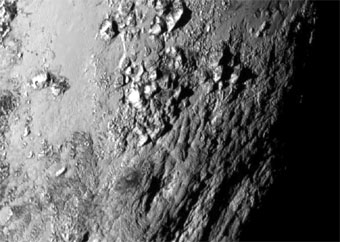
New Horizons Phones Home
| published July 15, 2015 |
By Keith H. Roberts
Thursday Review contributor
Though some of the data which is being sent back by NASA’s New Horizons spacecraft will take many months—perhaps as much as 16 months—to arrive here on Earth, scientists and engineers were nevertheless ecstatic when the long-distance spacecraft “phoned-home” shortly before 9 p.m. Eastern Daylight Time on Tuesday night, as planned.
New Horizons passed by Pluto and its largest moon Charon this week in a dramatic fly-by which took it to within 7,000 miles of the planet’s surface. New photos of Pluto’s icy, cragged surface are now giving scientists on Earth a closer, more detailed look at how our solar system evolved, and how the universe was created. New Horizons is also collecting vast reams of data and measurements, all of which will be sent back to NASA and to the special team at the Johns Hopkins University Applied Physics Laboratory in Laurel, Maryland.
Among the things scientists have already surmised: much of Pluto’s most visible features are recent, including rugged mountains which rise some 11,000 feet above the mostly level ice packed surface. The mountains appear to be part of a surprising new theory of how mountains form on the coldest planets, as Pluto’s jagged peaks may be formed from water-ice, not from the massive gravitational forces which explain mountains found on other planets. Scientists also believe now that Pluto is relatively young—perhaps less than 100 million years old. Pluto’s hard surface contains far fewer impact craters than were expected, and instead reveals more features like mountains and ridges.
Launched on January 19, 2006 as part of NASA’s larger New Frontiers program, New Horizons’ primary mission was a deep, detailed exploration of our solar system, and particularly those objects most distant from our sun. Since its launch nine and a half years ago, it has travelled more than three billion miles, moving at a speed of roughly 30,000 miles per hour—the fastest spacecraft ever launched from Earth. New Horizons has collected stunning imagery and detailed data from many objects along its carefully charted path—Earth’s moon, asteroids, Jupiter and Saturn and some of those giant’s moons, and still more asteroids. But the crescendo of its long journey was its dramatic close encounter this week with Pluto, classified for decades as the most distant planet in our solar system, though its membership in the club of planets has been at times controversial.
New Horizons will continue on its path deeper into the Kuiper Belt, a vast spherical region filled with thousands of objects—some as small as baseballs, others even larger than Pluto (and this may include Eris, the planet-like orb discovered in 2005 which is 27% larger than Pluto). Kuiper Belt objects will very likely contain deeply frozen materials which will help to explain many of the mysteries of the universe and give scientists a detailed look at the fundamentals of our solar system.
Pluto, which had been theorized to exists for years prior to its identification, was discovered in 1930, after which it became the first planet known to exist past the orbit of Neptune. But in the 1990s, Pluto’s characterization as a planet fell into disfavor by some astronomers and scientists, based largely on the fact that Pluto is in fact merely a prominent object within the wider Kuiper Belt. But Pluto was also already known to have moons—five in fact—and despite its icy surface and pockmarked appearance, eventually came to be called a planet again, especially after the 2005 discovery of Eris. Pluto and Eris may eventually become part of a group of outer spherical objects called Dwarf Planets, a category whose membership is sure to expand as New Horizons and future missions spacecraft missions give us a closer look at Earth’s most distant neighbors in our solar system.
Related Thursday Review articles:
A Close-Up Look at Distant Pluto; Keith H. Roberts; Thursday Review; July 15, 2015.
Battered Tethys; Keith H. Roberts; Thursday Review; June 17, 2015.
